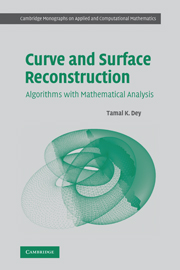8 - Noise and Reconstruction
Published online by Cambridge University Press: 20 August 2009
Summary
The algorithms for surface reconstruction in previous chapters assume that the input is noise-free. Although in practice all of them can handle some amount of displacements of the points away from the surface, they are not designed in principle to handle such data sets. As a result when the points are scattered around the sampled surface, these algorithms are likely to fail. In this chapter we describe an algorithm that is designed to tolerate noise in data.
The algorithm works with the Delaunay/Voronoi diagrams of the input points and draws upon some of the principles of the power crust algorithm. The power crust algorithm exploits the fact that the union of the polar balls approximates the solid bounded by the sampled surface. Obviously, this property does not hold in the presence of noise. Nevertheless, we have observed in Chapter 7 that, under some reasonable noise model, some of the Delaunay balls remain relatively big and can play the role of the polar balls. These balls are identified and partitioned into inner and outer balls. We show that the boundary of the union of the outer (or inner) big Delaunay balls is homeomorphic to the sampled surface. This immediately gives a homeomorphic surface reconstruction though the reconstructed surface may not interpolate the sample points.
- Type
- Chapter
- Information
- Curve and Surface ReconstructionAlgorithms with Mathematical Analysis, pp. 133 - 151Publisher: Cambridge University PressPrint publication year: 2006



